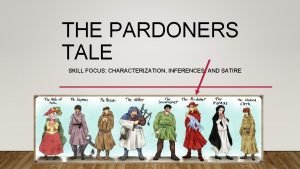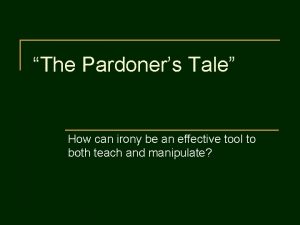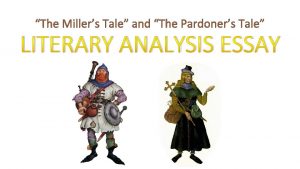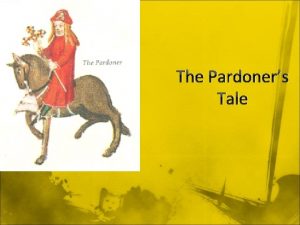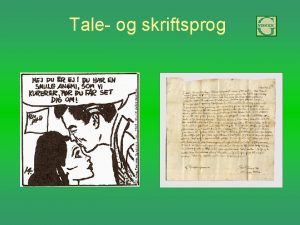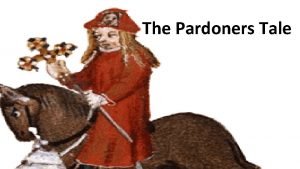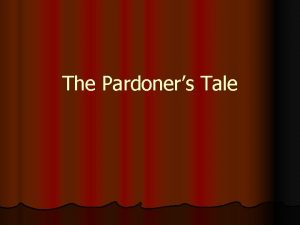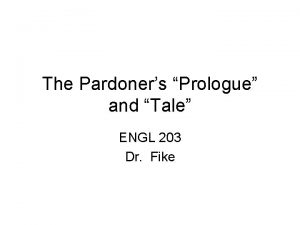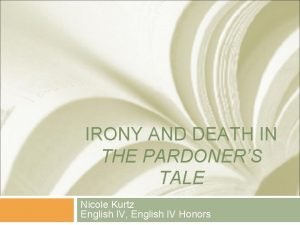The Pardoners Tale An introduction to the Medieval











- Slides: 11

“The Pardoner’s Tale” An introduction to the Medieval Period and Chaucer’s The Canterbury Tales

Medieval Period • a. k. a Middle Ages • 5 th century-16 th century • Spoke and wrote Middle English • Old English • Middle English • Modern English

Old English • A combination of • Celtic • Latin • Anglo-Saxon (Germanic language) • And Viking words Credit: Read by J. B. Bessinger, Jr. From Beowulf and Other Poetry. Copyright © 1984 by Harper. Collins Publishers, Inc. Used by arrangement with Harper. Collins. Probably the earliest extant Old English poem, composed sometime between 658 and 680. Cf. NAEL 1. 23.

Middle English • Old English with the addition of Norman French Credit: Read by Alfred David, Indiana University. The three rioters meet an old man. Cf. NAEL 1. 291; MA 254.

Modern English • 15 th century on • Includes Shakespeare! Sonnet 146 ("Poor soul, the center of my sinful earth"), William Shakespeare, 1609. Credit: Read by James Knapp. Cf. NAEL 1. 1042; MA 506.

Medieval Period • Influence of the Catholic Church • Unified the people • Central administration (network of bishops) • Literacy and learning • Teachers • Wrote, recorded, and copied literature and history of the times • Crusades

Medieval Period • Black Death • Bubonic & pneumonic plagues • 4 out of 5 people who contracted the plague died within 8 days • About 50% of Europe’s population died within a 4 year period

“The Pardoner’s Tale” • Written by Geoffrey Chaucer in the 1300 s • Part of The Canterbury Tales • Frame story: an overall unifying story in which other stories are told • Pilgrims on a journey to visit the tomb of a saint in Canterbury swap stories to pass the time

“The Pardoner’s Tale” • Story told by the Pardoner • Pardoner--a man who sells indulgences (pardons) for the church • Sells fake relics to cheat the “poor upcountry” people • Theme of his story is that “radix malorum est cupiditas”--Greed is the root of all evil

“The Pardoner’s Tale” • Allegory--a narrative in which characters, settings, and objects stand for abstract or moral concepts • Can be read both literally and symbolically • I. e. personified Death • Inspired “The Tale of the Three Brothers” in the last Harry Potter novel

Audio Recordings "The Norton Anthology of English Literature: Archive. " The Norton Anthology of English Literature: Archive. The Norton Anthology of English Literature: Archive, n. d. Web. 07 Apr. 2013.
 What inference can be made about the pardoner?
What inference can be made about the pardoner? Situational irony in the pardoner's tale example
Situational irony in the pardoner's tale example Folk tale characteristics
Folk tale characteristics Hình ảnh bộ gõ cơ thể búng tay
Hình ảnh bộ gõ cơ thể búng tay Frameset trong html5
Frameset trong html5 Bổ thể
Bổ thể Tỉ lệ cơ thể trẻ em
Tỉ lệ cơ thể trẻ em Gấu đi như thế nào
Gấu đi như thế nào Glasgow thang điểm
Glasgow thang điểm Hát lên người ơi alleluia
Hát lên người ơi alleluia Môn thể thao bắt đầu bằng từ đua
Môn thể thao bắt đầu bằng từ đua Thế nào là hệ số cao nhất
Thế nào là hệ số cao nhất
